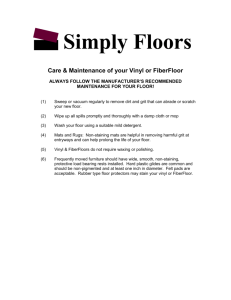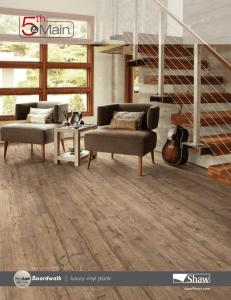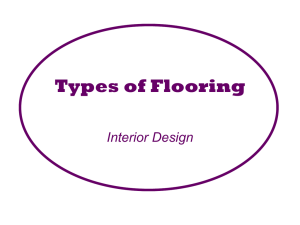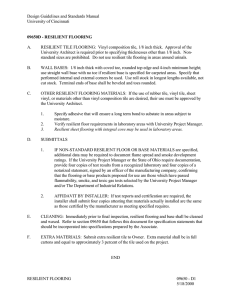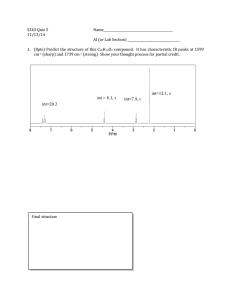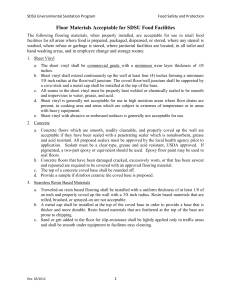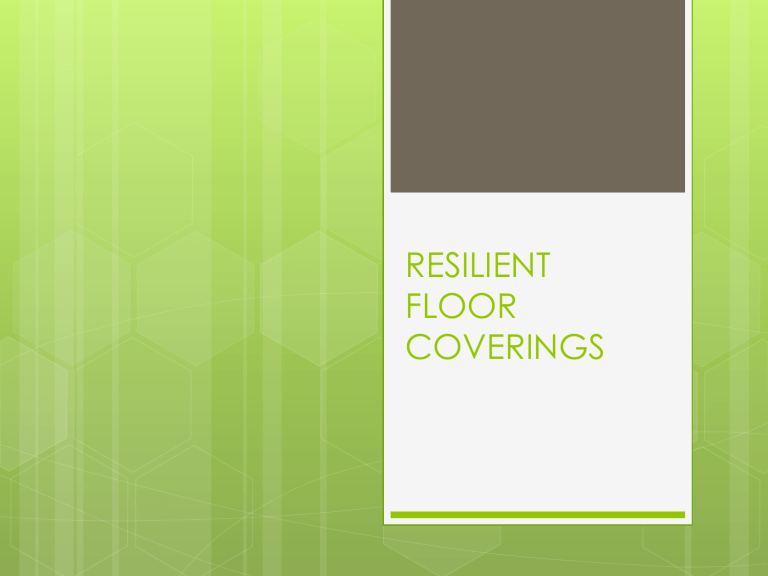
RESILIENT FLOOR COVERINGS KINYUA BRIAN MURITHI KINUTHIA GEROGINA WAMBUI KYALO PATRICK KELI KIOKO SHAWN MWENDWA VINLY FLOOR FINISHING INTRODUCTION Vinyl flooring is a durable and resilient material that is nearly impervious to water damage and resistant to almost all staining agents. It is easy to maintain, long lasting and relatively inexpensive. All of these characteristics combine to make vinyl one of the most popular flooring choices for both residential and commercial projects. Vinyl / Resilient Flooring Facts Resilient vinyl flooring is a great choice for kitchens and bathrooms because it’s Easy to keep clean It’s durable, Water resistant Doesn’t fade, stain, or dent. Vinyl flooring, also called resilient flooring, comes in so many colors, textures, and patterns. There two types of vinly floor finishing 1. 2. Tile Vinly floor finishing Sheet vinly floor finishing Characteristics of Sheet Vinyl Flooring Less Expensive : Sheet vinyl generally costs less than tile or plank materials. This is because they can mass produce it in large rolls, without having to worry about precision cuts and waste materials. Impermeable To Moisture Probably the biggest advantage of sheet vinyl over tile is the fact that it can usually be installed in just one or two solid, unbroken pieces. That means that you do not have seams running between individual pieces Design Options: . In sheet form printed vinyl can be inscribed with almost any pattern, color, or image that you desire. This is printed right into the surface layer of the floor covering, and is then installed directly into the room without having to worry about assembly. Characteristics of Tile Vinyl Flooring Replaceable: With tile vinyl floors, when an area on the surface gets damaged you can simply remove and replace the tiles. Removing vinyl tile is a matter of heating the adhesive beneath it, and then pulling the tile up and scraping away the bonding agent below. From there you can replace the tile with another for a repair job that will be completely integrated into the rest of the floor. Patterns and Design Options individual pieces can be mixed to create elaborately colored designs which will match and contrast across the entire surface of the floor. With tile you have the option of cutting individual pieces down into other shapes and sizes. With a square piece you can easily measure out consistent rectangles, or even triangles, to get really creative with the flooring installation processIntricate Vinyl Tile Floor Ease of Installation hand vinyl tiles are relatively easy to install and the project can usually be done by a moderately skilled amateur in about a day or two. The individual tiles do have to be laid in straight rows, but because they are separate pieces each mistake is less wasteful. Realism hand vinyl tiles are relatively easy to install and the project can usually be done by a moderately skilled amateur in about a day or two. The individual tiles do have to be laid in straight rows, but because they are separate pieces each mistake is less wasteful. How Vinyl / Resilient Flooring Is Made Vinyl flooring is made up of layers of material starting with a core of vinyl over a backing of felt or fiberglass. Decorative designs are printed on the next layer that sits on top of the core. That decorative design layer is what makes vinyl flooring so versatile. It can be made to look like almost any material. The final layer is also vinyl and is called the wear layer. Rotogravure The key to the many faces of vinyl flooring is the printing process, called rotogravure. Using a rotary press with photoengraved plates allows manufacturers to create the look of stone, brick, marble, wood and hundreds of other patterns and designs. And if that wasn’t enough, some manufacturers enhance the design by adding color or colored vinyl chips to the wear layer coating to add more depth to the design. Wear Layer Practically speaking, the wear layer, the last one applied, is most important. This top layer of vinyl is about 10 mils thick on average. (A straight human hair is about 1 mil. thick.) The thicker the wear layer, the more durable the flooring. Vinyl / Resilient Flooring Styles Variations In Vinly Artistic large pattern installations Since resilient vinyl flooring comes in sheets, planks and tiles (VCT or Vinyl Composition Tiles), there’s lots of room for self-expression. An artistic installer can use contrasting sheet vinyl to create large patterns. The tiles can be arranged any way you want them. Think Warm and cushy carpet installation Resilient vinyl floors share some of the same attributes as carpet — flexible and soft to walk on. What's more, like carpet, it can go on a subfloor that isn’t perfectly level. Vinly Flooring In Bathrooms Hard tile vinly flooring can be glazed, a process which creates a molten glass protective barrier over the surface of the material. This barrier is impervious to stains, water penetration, and mold, and can be printed to look like a variety of natural stone and hardwood materials. Those combined traits make ceramic a popular choice for bathrooms. Resilient vinyl flooring offers homeowners these advantages: It’s tough and resists scratching, denting and tearing It cleans easily and doesn’t need to be waxed It resists staining and scratching
